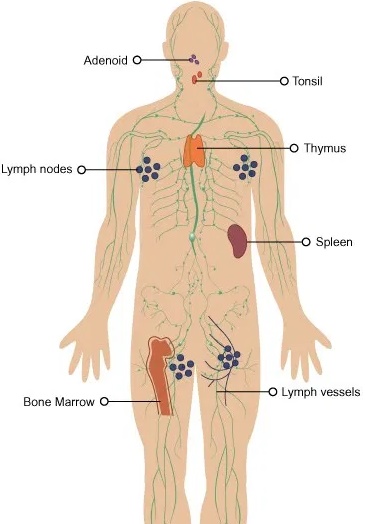
Week 14: Introduction to Immunology, the blood system and the Lymphatic system.
Fluid Systems of the Body
There are two main fluid systems in the body: blood and lymph. The blood and lymph systems are intertwined throughout the body and they are responsible for transporting the agents of the immune system.
The Blood System
The 5 liters of blood of a 70 kg (154 lb) person constitute about 7% of the body's total weight. The blood flows from the heart into arteries, then to capillaries, and returns to the heart through veins.
Blood is composed of 52–62% liquid plasma and 38–48% cells. The plasma is mostly water (91.5%) and acts as a solvent for transporting other materials (7% protein [consisting of albumins (54%), globulins (38%), fibrinogen (7%), and assorted other stuff (1%)] and 1.5% other stuff). Blood is slightly alkaline (pH = 7.40 ± .05) and a tad heavier than water (density = 1.057 ± .009).
All blood cells are manufactured by stem cells, which live mainly in the bone marrow, via a process called hematopoiesis. The stem cells produce hemocytoblasts that differentiate into the precursors for all the different types of blood cells. Hemocytoblasts mature into three types of blood cells: erythrocytes (red blood cells or RBCs),
leukocytes (white blood cells or WBCs), and thrombocytes (platelets).
The leukocytes are further subdivided into granulocytes (containing large granules in the cytoplasm) and agranulocytes (without granules). The granulocytes consist of neutrophils (55–70%), eosinophils (1–3%), and basophils (0.5–1.0%). The agranulocytes are lymphocytes (consisting of B cells and T cells) and monocytes. Lymphocytes circulate in the blood and lymph systems, and make their home in the lymphoid organs.
There are 5000–10,000 WBCs per mm3 and they live 5-9 days. About 2,400,000 RBCs are produced each second and each lives for about 120 days (They migrate to the spleen to die. Once there, that organ scavenges usable proteins from their carcasses). A healthy male has about 5 million RBCs per mm3, whereas females have a bit fewer than 5 million.
The goo on RBCs is responsible for the usual ABO blood grouping, among other things. The grouping is characterized by the presence or absence of A and/or B antigens on the surface of the RBCs. Blood type AB means both antigens are present and type O means both antigens are absent. Type A blood has A antigens and type B blood has B antigens.
Some of the blood, but not red blood cells (RBCs), is pushed through the capillaries into the interstitial fluid.
The Lymph System
Lymph is an alkaline (pH > 7.0) fluid that is usually clear, transparent, and colorless. It flows in the lymphatic vessels and bathes tissues and organs in its protective covering. There are no RBCs in lymph and it has a lower protein content than blood. Like blood, it is slightly heavier than water (density = 1.019 ± .003).
The lymph flows from the interstitial fluid through lymphatic vessels up to either the thoracic duct or right lymph duct, which terminate in the subclavian veins, where lymph is mixed into the blood. (The right lymph duct drains the right sides of the thorax, neck, and head, whereas the thoracic duct drains the rest of the body.) Lymph carries lipids and lipid-soluble vitamins absorbed from the gastrointestinal (GI) tract. Since there is no active pump in the lymph system, there is no back-pressure produced. The lymphatic vessels, like veins, have one-way valves that prevent backflow. Additionally, along these vessels there are small bean-shaped lymph nodes that serve as filters of the lymphatic fluid. It is in the lymph nodes where antigen is usually presented to the immune system.
The human lymphoid system has the following:
· primary organs: bone marrow (in the hollow center of bones) and the thymus gland (located behind the breastbone above the heart), and
· secondary organs at or near possible portals of entry for pathogens: adenoids, tonsils, spleen (located at the upper left of the abdomen), lymph nodes (along the lymphatic vessels with concentrations in the neck, armpits, abdomen, and groin), Peyer's patches (within the intestines), and the appendix.


